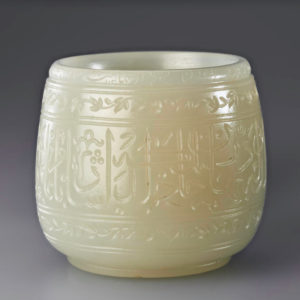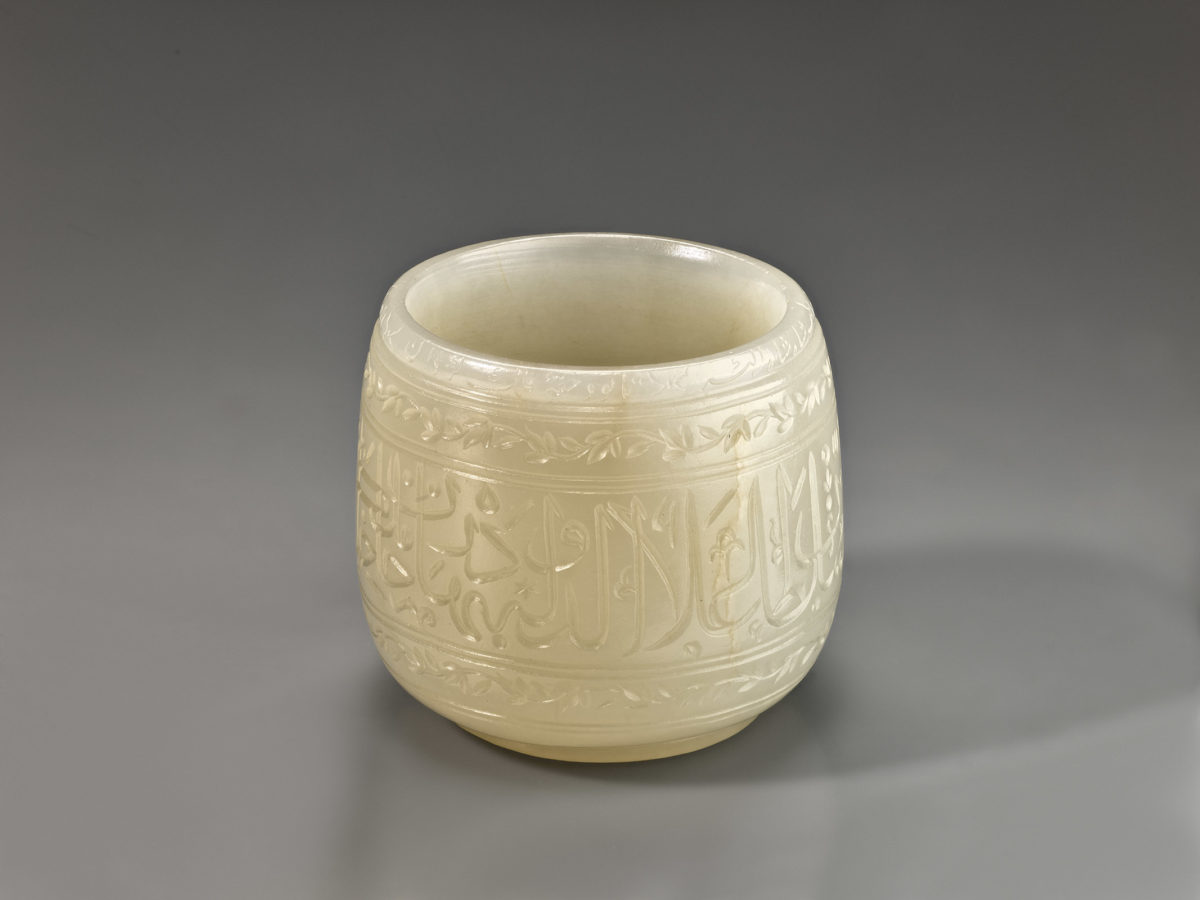Made of rare white jade, this tiny inscribed cup speaks volumes about the past.

Cup with calligraphic inscriptions
Probably 1447–1449
Probably Uzbekistan; Samarqand
Timurid period (1370–1507)
Nephrite
The Avery Brundage Collection, B60J619
Small, beautiful, and rare — this tiny cup speaks volumes about the past. At just over one inch tall and less than two inches in diameter, this cup from Central Asia offers a glimpse into how ideas about personal identity, family history, power, and prestige were conveyed through exquisite art objects. Made of white jade — rarer than green jade — the cup features the written word as its main decoration. It boasts royal inscriptions made nearly two centuries apart, one citing a Timurid ruler and the other a Mughal emperor in India.

Names of owners or artists on artworks are relatively uncommon in art from the Islamic world. It is unusual then that this cup bears the names and titles of both its royal patron, ‘Ala ud-Daulah, and subsequent owner, Jahangir, reflecting pride and pleasure in a beautiful object and, perhaps, the very human desire to be remembered.
On the body, in Arabic:
The sultan, son of the sultan, ‘Ala ud-Daulah Bahadur Khan, may [God] perpetuate his kingdom, ordered the completion of this container (durj).
On the rim, in Persian:
This life-prolonging jade container belongs to Jahangir Shah, son of Akbar Shah. For as long as the angels’ durj [the celestial sphere] revolves, may the world remember Jahangir Shah AH 1030 [1620–21 CE]; 16 [sixteenth year of Jahangir’s reign].
(Adaptations of translations by Wheeler Thackston)
The elegant inscription around the body of this cup states it was made for ‘Ala ud-Daulah. Little is known about ‘Ala ud-Daulah’s life, but his name lives on through this inscription. He probably ordered this cup during his brief two-year rule. It suggests that ‘Ala ud-Daulah, who came from a family renowned for its patronage of the arts, was a man of refined tastes who appreciated fine workmanship.
‘Ala ud-Daulah (1417–1460) was a great-grandson of Amir Timur (Tamerlane), founder of the Timurid Empire that ruled over parts of Iran, Afghanistan, and Uzbekistan during the 15th century. After the death of his grandfather, Sultan Sharukh, ‘Ala ud-Daulah claimed the Timurid throne with the support of his powerful grandmother. ‘Ala ud-Daulah lost power to his uncle after only one year as king and spent much of his remaining life in exile.
The prominence of the inscription and reference here to ‘Ala ud Daulah as sultan suggests this cup may have been made during his brief kingship between 1447 and 1449.
Nearly 175 years later, this cup made its way to India, probably as a gift to the Mughal emperor Jahangir (ruled 1605–1627), and a second inscription was added to its rim. Only a few millimeters in size, this masterful and eloquent inscription speaks to how highly prized this cup was for its new owner.
Composed as a lyrical short poem in Persian and barely visible to the naked eye, this inscription bears Jahangir’s name, his father Emperor Akbar’s name, and a date. The inscription’s content and its refined calligraphy reflect the emperor’s pride in owning this cup.
The Mughals were descendants of the Timurids, and Jahangir was a connoisseur known for collecting artworks associated with his culturally sophisticated ancestors.
Jahangir began marking his place in a family lineage through artworks. Inscriptions mentioned Jahangir’s name along with his father’s and their Timurid ancestors’, thus “collapsing historical time and bringing together royal ancestors in an imaginary family reunion.” This practice was continued by the later Mughal emperors Shah Jahan and Aurangzeb.
The inscriptions on this cup call it a durj, which in Arabic and Persian denotes a small container used as a jewel box. Drawing on the use of durj in Persian poetry, where it serves as a metaphor for a cup holding “rubies” (red wine), some scholars suggest that this cup was used as a drinking vessel
Calligraphy is the highest form of art in Islamic culture. The elegant writing on this cup was likely composed on a paper template before it was “carved” into the jade. Calligraphers needed many skills, among them command over the various script styles, impressive hand-eye control, and an artistic eye.
Traditional Islamic calligraphers spent countless hours preparing their tools, beyond the years of training required to master various scripts. Their basic implements include pens made of dried, hollow reed or bamboo (kalem); a penknife; a small, flat slab on which the reed pen would be positioned for cutting (makta); scissors; and an inkpot.
Many tools were artistic works in their own right, collected by calligraphers and rulers alike.
This cup is just one of two known works in this color and material associated with Timurid rulers. Although there was a long tradition of working other stones in the Islamic world, jade came into use for vessels and ornaments under the rule of the descendants of Timur.
Jade: A Prized Material
For millennia, the regions of Khotan and Kashgar in present-day Xinjiang, China, were important sources of jade from China to Iran. What we call “jade” is the gem name for two different minerals that are almost impossible to tell apart by visual inspection: nephrite (common) and jadeite (rare). Nephrite appears in a range of colors, including variegated and pure greens, browns, and whites. The pure, translucent white of this cup is among the rarest and most sought-after hues.
Working Jade
Jade is a difficult material to manipulate. It is too hard and dense to be carved like stone with cutting tools. Instead, jade is worked like gemstones, using manual rotary tools and an abrasive wet paste.
The elegant, curving letters of the script and the vine borders on this cup’s small, rounded surfaces — as well as the foliage decorating the bottom — required extreme precision and patience, and the talents of highly skilled artists. It has been suggested that Jahangir’s inscription was composed, designed, and carved by the multitalented head of the imperial goldsmith’s workshop.